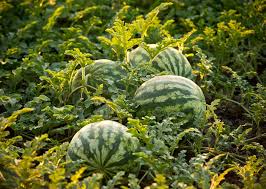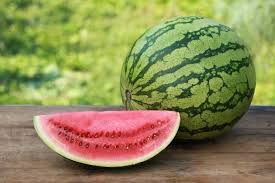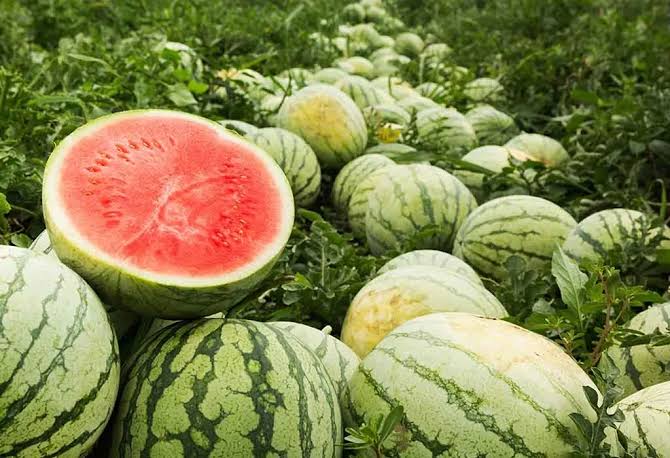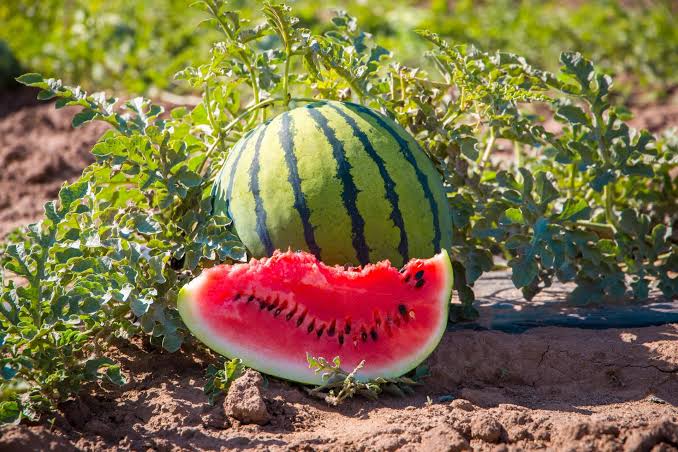Watermelon is a juicy and refreshing fruit that many people enjoy, especially during hot summer days. It has a vibrant red or pink flesh, filled with black seeds or seedless, depending on the variety. This delightful fruit is not only delicious but also packed with hydration, making it a perfect choice to quench your thirst.
The taste of watermelon is sweet with a hint of crispness, creating a satisfying sensation with each bite. Its high water content, approximately 92%, makes it an excellent choice to stay hydrated, contributing to your overall well-being.
Beyond its pleasing taste and hydration benefits, watermelon offers a rich source of essential vitamins and minerals. It contains vitamin C, which supports a healthy immune system, and vitamin A, essential for good vision. Additionally, watermelon contains antioxidants like lycopene, known for its potential health benefits.
Whether enjoyed in slices, chunks, or blended into a refreshing smoothie, watermelon adds a burst of natural sweetness to your palate. Its versatility makes it a popular ingredient in salads, fruit bowls, and even savory dishes. The subtle sweetness of watermelon pairs well with various flavors, enhancing the overall culinary experience.
In addition to being a tasty treat, watermelon has a symbolic presence in many cultures. It is often associated with summer festivities, picnics, and outdoor gatherings. The vibrant green rind contrasts with the bright interior, creating an inviting and visually appealing fruit that adds color to any occasion.
Growing watermelons involves patience and care. The fruit thrives in warm climates and requires well-drained soil. Farmers carefully tend to the watermelon plants, ensuring optimal conditions for growth. The process from planting to harvesting involves a series of stages, with the reward being the sweet and juicy watermelon that graces our tables.
Watermelon has become a staple at barbecues, beach outings, and family celebrations. Its ability to bring people together and evoke a sense of joy makes it a beloved fruit across the globe. Whether you savor it as a solo snack or share it with friends and family, watermelon remains a delightful symbol of summer and good times. So, the next time you bite into a juicy slice of watermelon, savor not just the taste but the memories and happiness it brings.
Read Also: Importance and Types of Pets
Growing and Care Guide of Watermelon

Growing watermelons can be a rewarding experience, and with proper care, you can enjoy the sweet fruits of your labor. Here’s a simple guide to help you cultivate and care for watermelon plants:
1. Choose the Right Variety: Select a watermelon variety that suits your climate and gardening space. Common types include seedless, seeded, mini, and yellow-fleshed watermelons. Check the seed packet or plant label for specific details on each variety.
2. Planting: Choose a sunny location with well-draining soil for planting. Watermelons thrive in warm temperatures. Plant seeds or seedlings after the last frost date in your area. Ensure there is enough space between plants for proper growth.
3. Soil Preparation: Watermelons prefer slightly acidic to neutral soil. Amend the soil with organic matter, such as compost, to improve fertility and drainage.
4. Watering: Watermelons need consistent moisture, especially during the growing season. Provide deep, regular watering to keep the soil evenly moist. Avoid overwatering, as waterlogged soil can lead to root rot. Mulching around the plants helps retain soil moisture.
5. Fertilization: Apply a balanced fertilizer with a higher ratio of nitrogen early in the growing season. As the plants develop fruits, switch to a fertilizer higher in phosphorus to support fruit development.
6. Support and Space: Consider using supports or trellises for vining varieties to save space and encourage proper air circulation.
Space plants according to the recommendations for the specific variety, ensuring they have enough room to spread.
7. Pollination: Watermelons require pollination for fruit set. Bees and other pollinators play a crucial role. Avoid using pesticides that harm pollinators.
8. Pruning: Trim excess foliage to allow sunlight to reach the developing fruits. This helps prevent diseases and ensures proper ripening.
9. Pests and Diseases: Monitor for common pests like aphids and cucumber beetles. Use natural methods or insecticidal soaps to control infestations. Keep an eye out for signs of diseases such as powdery mildew. Proper spacing and good air circulation can help prevent these issues.
10. Harvesting: Harvest time varies depending on the watermelon variety. Look for signs such as a dull rind, a yellow spot where it rested on the ground, and a hollow sound when tapped.
Cut the watermelon from the vine using sharp, clean tools.
By following these guidelines, you can cultivate healthy watermelon plants and enjoy the sweet, juicy rewards at harvest time.
Uses of Watermelon

Watermelon has versatile uses beyond being a refreshing snack. Here are some creative and practical ways to enjoy this delicious fruit:
1. Fresh Snacking: Enjoy watermelon slices as a hydrating and healthy snack on hot days. Its natural sweetness makes it a favorite for both kids and adults.
2. Salads and Salsas: Incorporate diced watermelon into salads for a burst of flavor and juiciness. Combine it with feta cheese, mint, and a drizzle of balsamic glaze for a delightful summer salad. It also makes a tasty addition to fresh salsas.
3. Smoothies and Beverages: Blend watermelon chunks into refreshing smoothies. Add mint, lime, or other fruits for an extra flavor kick. You can also make watermelon-based beverages, like agua fresca or watermelon lemonade.
4. Frozen Treats: Freeze watermelon cubes for a healthy and cooling treat. They make delicious popsicles or can be blended into a sorbet-like consistency.
5. Fruit Bowls and Platters: Create vibrant fruit bowls or platters with a variety of fresh fruits, including watermelon. It adds color and sweetness to the mix, making it visually appealing and tasty.
6. Gazpacho: Experiment with savory dishes by adding diced watermelon to gazpacho, a chilled soup made with tomatoes, cucumbers, and other fresh ingredients. The sweetness of watermelon complements the savory flavors.
7. Grilled Watermelon: Surprise your taste buds by grilling watermelon slices. The heat enhances its natural sweetness, creating a unique and delicious side dish or dessert.
8. Watermelon Agave Sweets: Create a simple syrup using watermelon juice and agave nectar. Drizzle it over desserts like ice cream, cakes, or pancakes for a delightful and natural sweetness.
9. Juices and Cocktails: Extract fresh watermelon juice to enjoy on its own or use it as a base for refreshing cocktails. Combine it with mint, lime, or your favorite spirits for a summery drink.
10. Hydrating Popsicles: Make hydrating popsicles by blending watermelon with other fruits or coconut water. These frozen treats are perfect for staying cool on warm days.
11. Watermelon Skincare: Use watermelon as a natural skincare ingredient. Its high water content makes it hydrating, and applying fresh watermelon juice on your skin can leave it feeling refreshed.
12. Seeds Snack: Roast watermelon seeds for a crunchy and nutritious snack. They can be seasoned with spices for added flavor.
With its juicy and sweet characteristics, watermelon can be enjoyed in various culinary creations, adding a refreshing touch to your meals and snacks.
Read Also: The Appearance and Features of Cats
Economic Benefits of Watermelon

Watermelon contributes to several economic benefits, playing a significant role in the agricultural and food industries. Here are some of the economic advantages associated with watermelon cultivation and consumption:
1. Agricultural Income: Watermelon cultivation provides a source of income for farmers. The sale of watermelons contributes to the economic livelihood of agricultural communities, particularly in regions with favorable climates for cultivation.
2. Job Creation: The cultivation, harvesting, and processing of watermelons create employment opportunities. From farm labor to transportation and distribution, the watermelon industry supports jobs at various stages of production.
3. Export and Trade: Watermelons are often exported to meet international demand. Participating in global trade enhances a country’s economic position and fosters economic relationships with other nations.
4. Diversification of Agriculture: Watermelon cultivation allows for the diversification of agricultural activities. Farmers can choose to grow watermelons alongside other crops, providing a variety of products for both local and international markets.
5. Food Processing Industry: Watermelon serves as a raw material for the food processing industry. Companies use watermelon in the production of juices, snacks, and other processed products, contributing to the economic growth of the food sector.
6. Tourism and Hospitality: Watermelon festivals and events, often centered around the harvest season, attract tourists and locals. These events can boost local economies by promoting tourism and supporting hospitality services.
7. Value-Added Products: Beyond fresh consumption, watermelon is used in the production of value-added products such as jams, jellies, and preserves. This diversification adds value to the watermelon industry and expands market opportunities.
8. Research and Innovation: Continued interest and investment in watermelon farming lead to research and innovation. Improved cultivation techniques, disease resistance, and new varieties contribute to the sustainability and economic viability of the watermelon industry.
9. Retail and Grocery: Watermelon sales contribute to the revenue of retail and grocery stores. The popularity of watermelon, especially during peak seasons, attracts customers and drives sales in these outlets.
10. Economic Impact on Rural Areas: Watermelon farming often occurs in rural areas, and the economic benefits help sustain these communities. The influx of income from watermelon sales can have a positive impact on the overall development of these regions.
In summary, watermelon’s economic benefits extend beyond the farm gate, influencing various sectors such as agriculture, trade, food processing, and tourism. Its cultivation and consumption contribute to job creation, income generation, and the overall economic well-being of communities involved in the watermelon industry.
Read Also: Easy Gluten-Free Recipes

